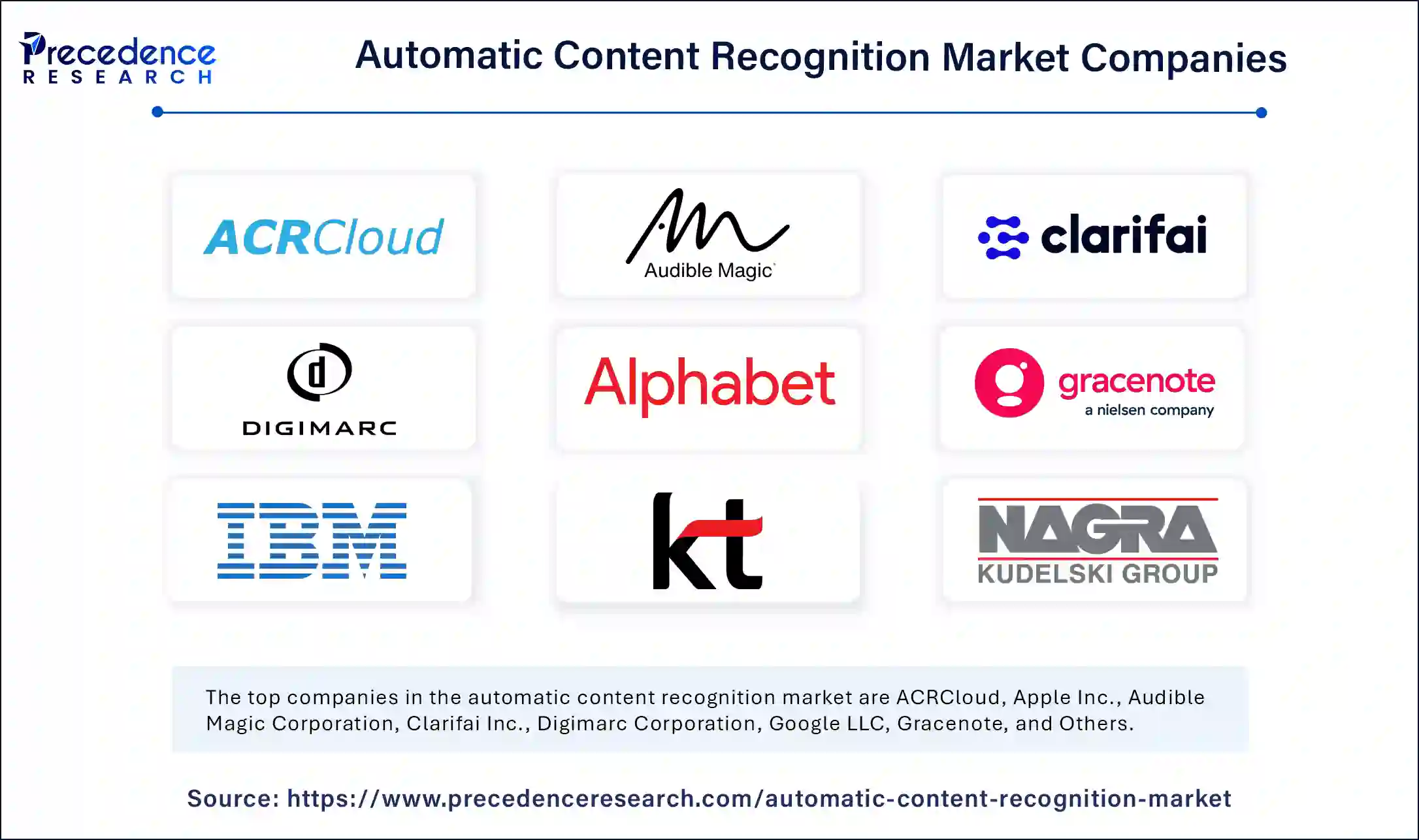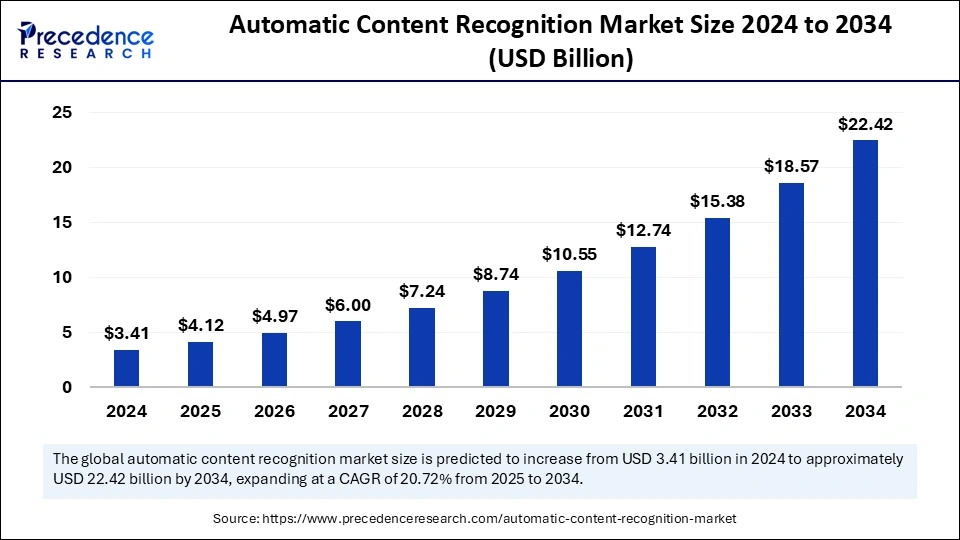Table of Contents
The global automatic content recognition market size was valued at USD 3.41 billion in 2024 and is expected to reach around USD 22.42 billion by 2034, growing at a CAGR of 20.72% from 2025 to 2034.
Get a Free Sample Copy of the Report@ https://www.precedenceresearch.com/sample/5758
Key Insights
-
North America led the automatic content recognition market with a 35% market share in 2024.
-
The Asia Pacific region is expected to grow at a CAGR of 22.6% throughout the forecast period.
-
The software segment dominated the market, accounting for 75% of the share in 2024.
-
The services segment is projected to grow at the fastest CAGR of 21.8% in the coming years.
-
The audio segment held the dominant market share in 2024.
-
The video segment is expected to expand at the highest CAGR during the studied period.
-
The smart TVs segment was the leading platform in the automatic content recognition market in 2024.
-
The over-the-top (OTT) segment is anticipated to grow significantly in the near future.
-
The audio & video fingerprinting segment captured the largest market share in 2024.
-
The optical character recognition segment is projected to witness the fastest growth between 2025 and 2034.
-
The media & entertainment segment led the industry verticals in 2024.
-
The healthcare sector is expected to expand at the highest CAGR over the forecast period.
-
The audience measurement segment dominated the application market in 2024.
-
The ad-tracking segment is likely to experience rapid growth over the projection period.
What is Automatic Content Recognition (ACR)?
Automatic Content Recognition (ACR) is a technology that enables devices to recognize audio, video, or images automatically without requiring user input. ACR is commonly used in smart TVs, mobile apps, and streaming services to identify media content and provide relevant information, recommendations, or interactive experiences. By analyzing digital signals, ACR can detect specific content, track viewership patterns, and synchronize multimedia across devices in real time.
How ACR Works
ACR works by using advanced algorithms such as fingerprinting, watermarking, and optical character recognition (OCR) to analyze and identify media content. These technologies compare audio or video snippets with a database to detect matches. When content is recognized, the system can deliver contextual data, such as metadata, additional content, or targeted advertisements, enhancing user engagement and improving content monetization.
Applications of ACR
-
Media & Entertainment: ACR helps streaming platforms and broadcasters analyze audience engagement, personalize content recommendations, and track viewership metrics.
-
Advertising & Marketing: Brands use ACR to measure ad effectiveness, track consumer interactions, and deliver targeted advertising based on real-time content recognition.
-
Smart TVs & OTT Platforms: ACR enables interactive TV experiences, second-screen applications, and personalized streaming suggestions.
-
Healthcare & Education: In healthcare, ACR aids in analyzing medical imaging and transcribing audio data, while in education, it enhances remote learning through speech recognition and automated captioning.
Role of AI in the Automatic Content Recognition (ACR) Market
AI is revolutionizing the automatic content recognition (ACR) market by enhancing content identification, personalization, and security. AI-driven ACR systems use machine learning algorithms to analyze and recognize audio, video, and text in real-time, enabling seamless content categorization and management. This technology plays a crucial role in personalized content recommendations, where AI studies user behavior to suggest relevant media, improving user engagement on streaming platforms.
Additionally, AI-powered ACR is widely used in ad tracking, helping advertisers monitor campaign performance and optimize ad placements. By analyzing audience reactions and engagement, AI ensures more targeted and effective advertising strategies.
Another significant impact of AI in ACR is in copyright protection and piracy detection. AI can detect unauthorized content distribution, helping media companies protect intellectual property and prevent revenue loss. Moreover, AI integration with smart devices enhances multi-screen synchronization, allowing interactive experiences across smart TVs, mobile devices, and OTT platforms.
AI also improves accessibility by enabling real-time speech-to-text transcription and voice-controlled interactions, assisting individuals with disabilities. Additionally, AI enhances security by detecting deepfake content and fake news, ensuring authenticity in digital media. As AI technology continues to advance, its role in ACR will further evolve, making content recognition more efficient, secure, and intelligent.
Market Overview
Automatic Content Recognition (ACR) is transforming digital media consumption by enabling real-time content detection, audience engagement, and targeted advertising. The market is experiencing substantial growth, fueled by the proliferation of smart TVs, mobile applications, and OTT platforms. ACR enhances the consumer experience by providing interactive and personalized content, leading to its increasing adoption across industries such as media, advertising, and entertainment.
Growth Factors of the Automatic Content Recognition (ACR) Market
-
Rising Demand for Personalized Content
The increasing preference for customized and interactive content is driving the adoption of ACR technology. Streaming platforms, smart TVs, and mobile applications use ACR to analyze user behavior and deliver tailored recommendations, enhancing viewer engagement. -
Expansion of Smart TVs and Connected Devices
The growing adoption of smart TVs, OTT platforms, and IoT-enabled devices is fueling the ACR market. As more households integrate smart entertainment systems, ACR plays a vital role in synchronizing content across devices and enabling seamless user experiences. -
Growing Digital Advertising and Targeted Marketing
ACR is widely used in the advertising industry for real-time audience measurement, ad tracking, and targeted marketing. Brands leverage ACR technology to analyze consumer engagement with commercials, optimize ad placement, and improve return on investment (ROI). -
Advancements in Artificial Intelligence and Machine Learning
AI-driven ACR solutions enhance content recognition accuracy, automate media analysis, and improve real-time content identification. The integration of machine learning algorithms allows ACR to detect audio and video content more efficiently, further accelerating its adoption. -
Increasing Popularity of Second-Screen Applications
The rise of second-screen experiences, where users engage with additional content on smartphones or tablets while watching TV, is boosting the demand for ACR. This technology enables seamless synchronization between devices, enhancing interactive engagement and multi-platform content consumption. -
Growing Applications in Healthcare and Education
Beyond entertainment and advertising, ACR is finding applications in sectors like healthcare and education. In healthcare, ACR is used for medical imaging analysis, while in education, it supports automated transcription, captioning, and real-time content accessibility. -
Adoption of Real-Time Data Analytics
Businesses and media companies are increasingly relying on real-time data analytics to understand consumer behavior and optimize content strategies. ACR provides valuable insights by tracking viewing habits, media consumption patterns, and ad effectiveness, contributing to its market growth. -
Government Regulations and Anti-Piracy Measures
Governments and media companies are leveraging ACR technology to combat content piracy and ensure copyright protection. ACR helps in detecting unauthorized content distribution, protecting intellectual property, and enforcing compliance with digital rights management (DRM) policies.
Market Scope
| Report Coverage | Details |
| Market Size by 2034 | USD 22.42 Billion |
| Market Size in 2025 | USD 4.12 Billion |
| Market Size in 2024 | USD 3.41 Billion |
| Market Growth Rate from 2025 to 2034 | CAGR of 20.72% |
| Dominated Region | North America |
| Fastest Growing Market | Asia Pacific |
| Base Year | 2024 |
| Forecast Period | 2025 to 2034 |
| Segments Covered | Component, Content, Platform, Technology, Industry Vertical , Application, and Regions |
| Regions Covered | North America, Europe, Asia-Pacific, Latin America and Middle East & Africa |
Market Dynamics
Market Drivers
The rapid shift toward AI-driven content analysis, the expansion of streaming services, and the growing need for data-driven insights are the key drivers of ACR market growth. Businesses are leveraging ACR technology to improve content recommendations, enhance ad targeting, and optimize audience measurement. Additionally, the rising demand for second-screen experiences and interactive marketing strategies has contributed to the increased deployment of ACR solutions.
Market Opportunities
The integration of ACR with blockchain technology for secure and transparent content recognition opens new avenues for growth. The increasing adoption of ACR in healthcare, education, and retail sectors also presents promising opportunities. With the development of smart cities and IoT-enabled environments, ACR is expected to play a crucial role in enhancing user engagement and data analytics across multiple industries.
Market Challenges
One of the primary challenges in the ACR market is ensuring compliance with data privacy regulations, as unauthorized content recognition can raise legal issues. Additionally, the high costs associated with implementing ACR technology, particularly for small and medium-sized enterprises, pose a barrier to market entry. The need for advanced AI models to improve content recognition accuracy and reduce false detections remains a technical challenge for developers.
Regional Insights
North America leads the ACR market, supported by strong technological infrastructure and the widespread adoption of digital entertainment services. Asia Pacific is emerging as a major growth hub, with increasing investments in digital media, smart TV adoption, and expanding online content consumption. Europe is also showing steady growth, driven by advancements in AI-powered advertising and audience analytics.
Recent Developments
- In December 2022, VIZIO announced a census-representative panel built using automatic content recognition (ACR) data from Inscape, VIZIO’s ACR data subsidiary.
- In September 2022, LG Electronics (LG) announced a rollout of LG Ads Solutions proprietary automatic content recognition (ACR) technology across LG TVs.
Automatic Content Recognition Market Companies

- ACRCloud
- Apple Inc.
- Audible Magic Corporation
- Clarifai Inc.
- Digimarc Corporation
- Google LLC (Alphabet Inc.)
- Gracenote
- IBM Corporation
- KT Corporation
- Kudelski Group
- Microsoft Corporation
- Nuance Communications Inc.
Segments Covered in the Report
By Component
- Software
- Services
By Content
- Audio
- Video
- Text
- Image
By Platform
- Smart TVs
- Linear TVs
- Over-The-Top (OTT)
- Others
By Technology
- Audio & Video Watermarking
- Audio & Video Fingerprinting
- Speech Recognition
- Optical Character Recognition (OCR)
- Others
By Industry Vertical
- Media & Entertainment
- IT & Telecommunication
- Automotive
- Retail & E-commerce
- IT & Telecommunication Electronics
- Government & Defense
- Others
By Application
- Audience Measurement
- Content Enhancement
- Broadcast Monitoring
- Content Filtering
- Ad-tracking
- Others
By Region
- North America
- Europe
- Asia Pacific
- Middle East & Africa
- Latin America
Also Read: B2B Continuing Education Market
Ready for more? Dive into the full experience on our website@ https://www.precedenceresearch.com/

